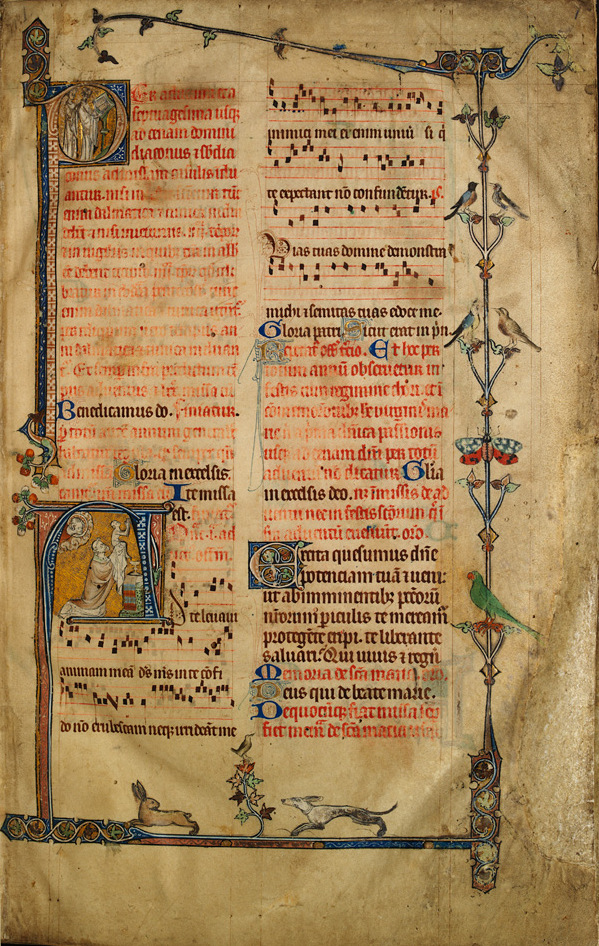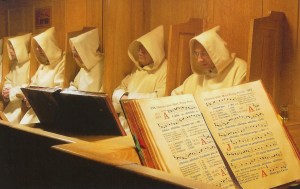Text is taken from BENEDICAMUS DOMINO

Apparuerunt Vultus Eorum Meliores
The entire Month of November is devoted, Scripturally, to the Twelve Minor Prophets of The Old Testament: The first two weeks (The Second Week is again omitted this year) to Ezechiel; The Third Week to Daniel; The Fourth Week and The Fifth Week to the rest, each having a day or two devoted to an excerpt of their respective Prophetic Books.
This is the final stretch, as these Prophets all point to not only The First Coming of Christ, but also, more especially, to His Second Coming, The Eschaton: Death, Judgment, Heaven, Hell. It is Eschatide.
Monastic Compline.
Available on YouTube at
Daniel and his three young companions (who, later tossed into the fire, gave us the famous Benedicite Canticle, sung at Sunday and Festal Lauds) were given alternative Babylonian names, and were expected to comport themselves and eat and drink as Babylonians.
They refused. They would not eat of the luscious meats and drink the wine of the King's Court; rather, they ate nothing but The Fruits of The Earth, vegetables (legumes to be more precise) for ten days. All expected them to suffer malnourishment, be weakened, and the eunuch in charge feared retribution from the King, for Daniel's and his Companions' refusal to defile themselves. Instead, the Scripture tells us, after ten days apparuerunt vultus eorum meliores, that is, their faces/complexions appeared better.

This beautiful Missal, made from Parchment, originates from East Anglia, England.
It is considered a very important Manuscript as it is one of the earliest
examples
of a Missal of an English source.
Sarum Missals were books produced by
The Church
during The Middle Ages for Celebrating Mass throughout the Year.
Date: Circa 1310-1320.
Source: National Library of Wales
(Welsh: Llyfrgell Genedlaethol Cymru),
Aberystwyth, Wales.
Author: Unknown.
(Wikimedia Commons)
He says: "Their countenances appeared fairer than all the children which did eat the portion of the King's meat. Seest thou what Fasting doth. It healeth diseases, it drieth up the humours of the body, it scareth away devils, it purgeth forth unclean thoughts, it maketh the intellect clearer, it purifieth the heart, it sanctifieth the body, and, in the end, it leadeth a man unto The Throne of God."
Both body and Soul are refreshed, and, based on personal experience, it is quite true that I feel more refreshed, energetic, and diligent, both corporeally and Spiritually, during periods of Fast such as Lent, Ember Days, and Vigils.
Sergej Rachmaninov.
Vespers (All-Night Vigil).
Available on YouTube at
Hence, there is an old custom of a Martinmas Fast, that, after having Celebrated The Last Octave of The Liturgical Year (All Saints) and The Feast of the great Lyonese Bishop of antiquity (Saint Martin of Tours) with lanterns and duck (or goose), as customary, we divest ourselves, yet again, of the creature comforts of food and drink and both end one Liturgical Year and embark on a New Liturgical Year with a Fast.

The Sherborne Missal.
Date: 15th-Century.
Source: British Library Add. MS 74236.
Author: Unknown.
(Wikimedia Commons)
Fasting from 12 November 'til 24 December would be entirely and laudably counter-cultural to the materialism, gluttony, drunkenness, and debauchery that is about to kick into high gear with the faux "Holiday Season", which has nothing whatsoever to do with Advent, Christmas, and Epiphany. I conclude with the final passage today from Saint Athanasius:

Carthusian Monks at Marienau Monastery,
It is the only extant Carthusian Monastery in Germany.
Illustration: MIKE'S PASSING THOUGHTS
If any man, therefore, be troubled with an unclean spirit, if he bethink him of this, and have recourse to this remedy, namely, Fasting, the evil spirit will be forthwith compelled to leave him from dread of the power of Fasting.
Devils take great delight in fulness, and drunkenness, and bodily comfort. There is great power in Fasting, and great and glorious things are wrought thereby. How cometh it that men work such wonders, and that signs are done by them, and that God, through them, giveth health to the sick, unless it be from their ghostly exercises, and the meekness of their Souls, and their Godly conversation.
To Fast is to banquet with Angels, and he that Fasteth is to be reckoned, so far, among The Angelic Host.

English: Cloisters of The Basilica of Saint Paul-without-the -Walls,
Rome, Italy.
Deutsch: Rom, Sankt Paul vor den Mauern
(San Paolo fuori le mura), Kreuzgang des Klosters.
Photo: 28 July 2007.
Source: Own work.
Author: Dnalor 01.
(Wikimedia Commons)

No comments:
Post a Comment